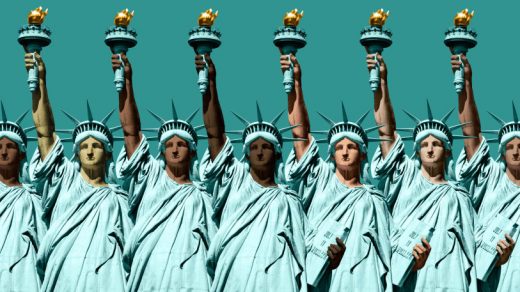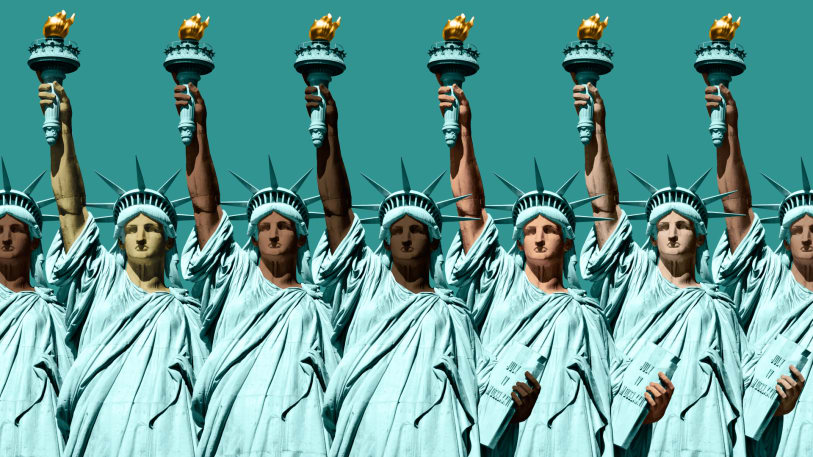How The ACLU Is Leading The Resistance
Anthony Romero was the first one into the office in lower Manhattan on Wednesday, November 9, 2016. He had spent the prior night at an election party hosted by George Soros, one of the ACLU’s biggest donors—an event that, according to Romero, was “like being at a wedding that turned into a funeral.”
Like many Americans, Romero had woken up to a political reality he had not expected. But unlike most of the country, the executive director of the ACLU had a clear vision of what came next. It was, after all, a scenario for which he had been preparing for months.
First thing that morning, Romero sat at his desk, which looks out across the New York harbor with a sweeping view of the Statue of Liberty, and wrote a letter to then president-elect Donald Trump. In it, he laid out several of Trump’s campaign promises—deportation forces to remove undocumented immigrants, a entry ban for Muslims, and restrictions on a woman’s right to abortion, among them—and succinctly explained how they violate the Constitution.

It was measured and authoritative. And it was a clear challenge: “[The ACLU has] worked with and battled American presidents of both parties to ensure that our country makes good on its founding premise as the land of the free,” Romero wrote. “If you do not reverse course and [do] endeavor to make these campaign promises a reality, you will have to contend with the full firepower of the ACLU at your every step.”
The ACLU had already planned an all-staff meeting for that morning, to be held near the nonprofit’s offices in the amphitheater of the National Museum of the American Indian. All of the ACLU’s roughly 300 New York City-based employees were invited, including 110 legal staffers, along with people working in development, advocacy, and communications. The 900-some employees from the organization’s 53 state affiliate offices (including three in California) were invited to call in.
Romero, who has led the ACLU for 16 years, acknowledged his employees’ disappointment and let them express it. But he didn’t let them linger on it. “This is what we are here for,” he reminded them. “We will get tested, and we will sometimes lose, but we will always be in the fight for the right reasons.”
After the meeting, he handed his letter to ACLU communications director Michele Moore, who had started earlier in the year with the directive to help make the 97-year-old nonprofit relevant again. Romero didn’t want the letter edited or toned down. He told Moore to just run with it. Two days later, Romero’s early-morning missive appeared as a full-page ad in the New York Times.
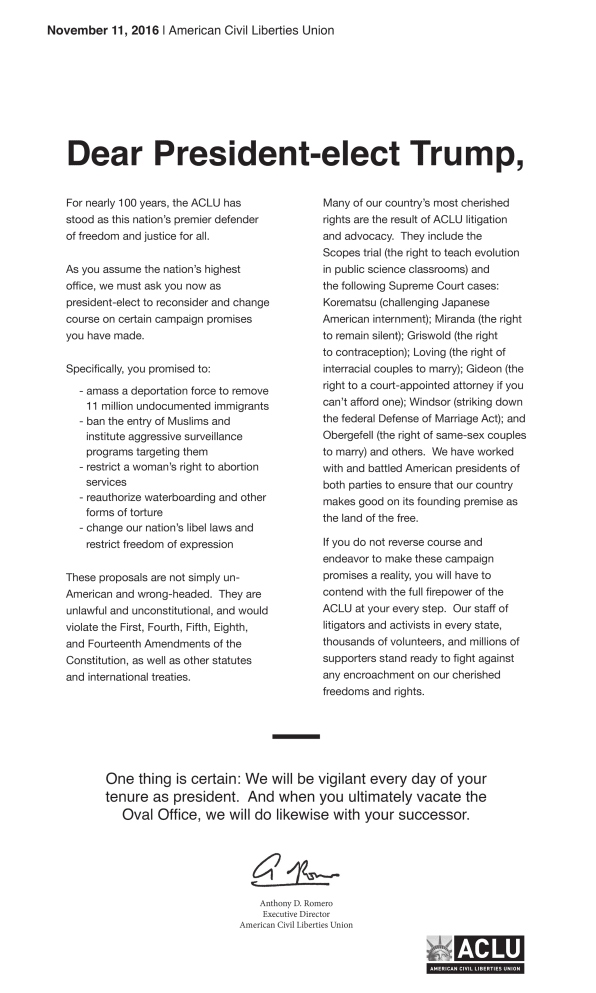
In the nearly six months since election night, the ACLU has fulfilled Romero’s promise, mounting some of the most prominent legal challenges to the Trump administration and becoming a de facto leader of what’s become known as “the resistance.” The organization and its affiliates have launched more than a dozen legal actions and Freedom of Information Act (FOIA) requests against the Trump administration. They’ve scored victories against both of the administration’s executive orders limiting the ability of people from some predominantly Muslim countries to enter the country (aka the travel bans), and recently joined with the County of Santa Clara in its successful suit to oppose the defunding of sanctuary cities. And they’ve ratcheted up the pressure in smaller ways, such as publishing a slew of documents relating President Trump’s business interests, obtained by a FOIA request. At the same time, the nonprofit has continued to pursue other civil-rights cases at state and national levels, which include battles for trans bathroom rights and various challenges to restrictions on reproductive freedom.
The ACLU was founded by a group of activists in the 1920s, when protesters were routinely thrown in jail for actions as benign as distributing anti-war literature. It was a time when states openly allowed violence and discrimination against African-Americans, when women had only just won the right to vote, and when LGBT people enjoyed absolutely no constitutional protections.
The landscape of American freedom looks vastly different now, thanks in part to the ACLU’s work on cases like Brown v. Board of Education to help end school segregation; Loving v. Virginia, which established lawful interracial marriage; and Roe v. Wade, confirming a woman’s constitutional right to abortion. More recently, the ACLU has taken on government surveillance and torture, and helped secure the right of gay couples to legally marry with the landmark 2015 Obergefell v. Hodges Supreme Court victory.
But the ACLU’s influence and profile today may be unmatched in its history, as the nonprofit mobilizes Americans to aid its efforts like never before. In his 16 years as executive director, Romero has doubled the organization’s size and budget. But that progress has skyrocketed since election day. Over the past six months, the number of card-carrying ACLU members has tripled from around 400,000 to 1.6 million, and more than $ 83 million in donations has flooded in—much of it from individuals donating online. That’s more than one-third of the ACLU’s annual budget. (The nonprofit has seen so much financial support that Romero has even urged donors not to forget other organizations in need.) The organization that this time last year was trying to figure out how to stay relevant is now the pet cause for celebrities and Silicon Valley luminaries, including Y Combinator president Sam Altman, who recently pledged the support of his high-profile startup accelerator.
The ACLU has responded by hiring and expanding and improving its operations, including creating its first-ever grassroots organizing arm. “Government has turned its back on the people, and the ALCU is leading the charge in saying, ‘We are here to listen, and we are here to be a part of a strategic plan,’” says Mark Rosenbaum, who spent 40 years at the ACLU’s Southern California chapter before becoming director of the Opportunity Under Law division of the pro bono law firm Public Counsel. “They are developing strategies and policies that are responsive to the real needs that are being voiced.”
This is all possible because the ACLU—under Anthony Romero—was ready for the president whom it calls “a one-man constitutional crisis.”

America’s Insurance Policy
More than six months before the media and much of the American public was blindsided by the election results, the ACLU was preparing for a Trump presidency. In May 2016, as Bernie Sanders conceded the Democratic primary and Trump secured enough delegates to claim the Republican primary, Romero directed his staff to begin compiling detailed reports on what, exactly, a Clinton and Trump presidency would mean for civil liberties and constitutional rights.
The ACLU is organized into 14 different project groups, each focused on a major issue, such as voting rights, criminal justice, surveillance, and immigration. Within each group, there are subgroups for specific topics, like detention or refugees. At any given time, the ACLU may be working on roughly 66 different subjects. For the candidate dossiers, Romero asked each project group to consider the politician through the lens of its issue.
For the Clinton report, the task was relatively simple. The teams had decades of Clinton policy statements to draw from, and they looked at what the appointment of a moderate Supreme Court nominee might mean for issues such as the death penalty and stop and frisk.
Building a detailed report on Trump was much more daunting—and unpopular. Romero concedes that some of the staff, already burdened with the pressure to wrap up pending litigation against the Obama administration, likely viewed it as “Anthony’s vanity project.” But he pushed forward. “Everyone was talking about Clinton, Clinton, Clinton. We had a Clinton plan and we were thinking about the transition, but we had to have a Trump plan because if he was to be elected, the challenges would have been too great to just [address] on the fly,” Romero explains when I meet him at his offices in early March.
To pull together the report, the ACLU hired an outside research firm and culled through all of Trump’s statements. “Then I said to the litigators, ‘Give me the best constitutional legal statutory analysis you would muster to fight these policies,’” Romero recalls.

The ACLU published “The Trump Memos” on July 13, 2016. (Since Clinton didn’t pose nearly as serious of a constitutional threat, the ACLU didn’t publish its memo on her until October.) The 27-page document took all of candidate Trump’s campaign rhetoric on six big issues (immigration, actions against Muslims, torture, libel, mass surveillance, and abortion) literally and seriously, drawing out his often vague or incoherent statements to their possible policy positions. Then it built a clear defense against each. “We had to take him at his word,” explains Moore. “So if he was talking about mass deportation forces, [we thought,] what does that mean in terms of [the] right to due process?” The ACLU had no way of knowing if or when the president would try to fulfill his campaign promises, but it created the backbone for its legal arguments just in case.
Today, the document reads like a detailed playbook for Trump’s first 100 days, and likely beyond. For example, the July memo explained that Trump’s own inflammatory campaign trail rhetoric against Muslims could be used to undermine any attempt at a country-based travel ban: “To the extent that Trump’s proposed ban has shifted from an explicit religion-based ban to a pretextual country-based ban, it remains unmistakably clear from the history of this proposal and the continuing focus on Muslims in public statements from the Trump campaign that the target continues to be adherents of a particular faith. The Constitution does not tolerate such discrimination.” This is the very argument that would help win over the Ninth Circuit judges more than six months later.
Why did Romero prepare for an outcome that everyone thought was unlikely? He says it’s just in his nature. “I have plan A, plan B, and plan C, and then I have to come up with plan D on the spot,” he explains. “We were the only nonprofit that put out a report on Trump. Our job was to be ready for the worst-case scenario.”
Being at the vanguard isn’t new for Romero. He has often filled the role of first: He is the first Latino and openly gay man to lead the ACLU, and was the first person in his family to graduate from high school. Born to immigrant parents from Puerto Rico, he spent his early childhood in public housing in the Bronx. He understood, at an young age, the hurdles that immigrants face: During Romero’s childhood, his father filed a grievance against the hotel he worked for when he was denied a promotion because of his limited English. Romero went on to Princeton, where he studied public and international affairs, and then Stanford law school.
After law school, he applied for a fellowship at the ACLU, but was turned down. He wound up at the Rockefeller Foundation, where he established himself as a civil-rights advocate. From there he took a position in the Civil Rights and Social Justice division of the Ford Foundation, where he became one of the youngest directors in the foundation’s history. It was there that he honed the fundraising skills that have been such a boon to the ACLU.
Romero became executive director of the ACLU one week before the September 11, 2001, terrorism attacks. “I hadn’t even unpacked my boxes yet, or gotten business cards,” he recalls. “It really required me to put my arms around the place and provide the leadership that the organization needed and that the country required.”
While Romero anticipated that the attacks might lead to increased nationalism and an erosion of civil liberties (similar to what happened in the aftermath of the Pearl Harbor attack), he decided to begin by addressing the country’s mood. His first press release, issued on September 20, took a decidedly patriotic tone, pledging that the ACLU would “work with our national leaders in their fight to bring those responsible for this tragedy to justice.”
Not all of his colleagues agreed with this approach. “Some people [within the ACLU] thought I was too nationalistic,” Romero says. “[But] you have to meet the client where they are. And our client, the American people, were grieving and stunned and afraid. [I said to the staff], we have to make sure that the public is ready to hear us. As soon as the Bush administration began to enact the Patriot Act or detain and deport immigrants, that’s when we were really at full throttle.”
Today, Romero views the ACLU as the U.S.’s insurance policy. Under his leadership, it has become an institution that prepares silently in the background and pushes forward as the need arises. Since Romero took the helm, his lawyers have battled cases both big (the end of Don’t Ask Don’t Tell in 2010; marriage equality in 2015) and lesser-known, and have challenged presidents, whether it was over George W. Bush’s mass surveillance efforts or the Obama administration’s deportations and use of drones in battle. And although the public might not have been interested in “The Trump Memos” last summer (“I think two people read it,” Romero jokes), the ACLU did its due diligence, just in case.
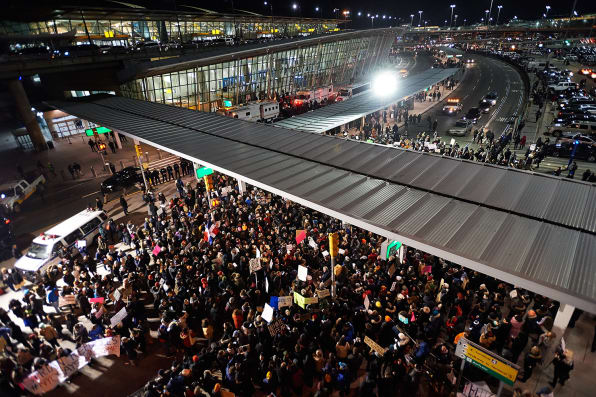
Winning In The Streets And In The Courtroom
On January 27, 2017, after less than a week in office, Trump signed the executive order that colloquially became known as the Muslim Ban. The order, which barred entry for people from seven Muslim-majority countries, regardless of their immigration status, was issued just before 5 p.m. on a Friday. It was timed, in other words, to surprise.
The immigration lawyers at the ACLU didn’t know that the order would come down that evening, but they did have advanced warning: According to Romero, someone within the White House had leaked a photocopied draft to the ACLU a few days earlier, and the organization had begun to map out its case. “We had figured out all the legal theories already,” Romero says. “We just needed to plug in clients.”
Two hours after the order was signed, Lee Gelernt, deputy director of the ACLU’s national Immigrants’ Rights Project, and his colleagues were on the phone with partner organizations, including the National Immigration Law Center and the International Refugee Assistance Project (IRAP). A couple hours later, lawyers with IRAP told Gelernt that two men from Iraq who had worked for the U.S. government were being detained at JFK airport; they would become the main plaintiffs in the case against the government. Gelernt and the others worked in shifts through the night and filed a habeas corpus lawsuit on behalf of their clients—and anyone else caught by the ban—in federal court just before 6 a.m. on Saturday, less than 12 hours after the order was issued.
As planes landed throughout the country, stories of people being detained began to proliferate. Gelernt had hoped for a fast response to their filing, but as the morning wore on, it became clear that they wouldn’t get a hearing that day. So Gelernt and his team quickly changed course: They needed someone to issue a temporary, emergency national stay on the executive order. Again they scrambled, working through the afternoon to file papers by 5 p.m. that Saturday. A half hour later, they reached a New York federal court judge, who told Gelernt to get lawyers from both sides to the Brooklyn courtroom in two hours.
By this time, crowds were halting traffic at airports, and the chaos surrounding the executive order had become the biggest national story. Gelernt quickly showered and headed down to Brooklyn. As he, Romero, the government lawyers, and a few activists filed into the courtroom, a small crowd started to gather outside.
The hearing began with a tense sense of urgency. Gelernt was handed a piece of paper from another lawyer: One of his clients was being put on a plane back to Syria in 25 minutes. According to Gelernt, the judge asked the Justice Department attorneys two questions: Would the individuals who are being deported and detained be a threat to national security if they were allowed to stay? And if we send these people back, are they going to be in harm’s way? The answers, apparently, were insufficient. The judge issued a nationwide injunction to block the deportation of people stranded by the executive order. The room erupted in cheers—something that never happens in federal court, says Gelernt.
Moments later, Romero and Gelernt exited the courthouse. “In my mind, [I thought] there were going to be maybe 40 people out there,” Gelernt says. The crowd that had gathered was estimated at 1,000 people. Reporters swarmed the lawyers. Phones went up to record; people were shushed. A shaky video of Romero and Gelernt explaining the court order was quickly posted on the ACLU’s Facebook page, where it now has more than 19 million views. The crowd started to chant “ACLU, thank you!” and high-fiving the lawyers.
Refugees will not be deported.
VICTORY: ACLU blocks Trump’s unconstitutional Muslim ban. WATCH: ACLU Executive Director Anthony D. Romero coming out of the court where the ACLU argued their case.
Posted by ACLU Nationwide on Saturday, January 28, 2017
Donations to the ACLU had started pouring in the day after the election, and thousands of people had carried ACLU-branded signs at the Women’s March on January 21. But it was outside that Brooklyn courthouse that the nonprofit solidified its position as a leader of the resistance. Over the course of that final weekend in January, the ACLU took in an unprecedented $ 24 million in online donations from roughly 350,000 people. Silicon Valley heavy hitters also got involved: Lyft pledged $ 1 million over four years and many other companies, including Instacart, Slack, and Google, pledged to match employee donations.
“[The ACLU has] always been fighting the fight, but they have often been invisible,” says Ilyse Hogue, president of NARAL Pro-Choice America, which often aligns with the ACLU’s reproductive rights team. “What’s new is that their legal work provides not just an opportunity to make sure that rights are maintained, but [it has become] a symbol of hope in very difficult times.”
The dramatic success of those 24 hours isn’t how the ACLU wins most of its cases, but it is indicative of how the organization works: a mix of careful planning, remarkable speed, and increasing agility. Its power and reach come not only from a strong core of specialized lawyers, but also a robust network of partner organizations and affiliate offices that allows the nonprofit to have meticulously planned cases that can be amended on the fly.
It’s where Romero’s plan A, B, C, and improvised plan D come into play. “[Anthony] thrives on these moments and gets energized by them,” says Gelernt. “He is very good at providing a broad-strokes narrative for the organization, but then letting the lawyers do their work and not micromanaging.”
A key part of this effort is the ACLU’s increasing reliance on its affiliates. Many of the organization’s legal battles are started and even won on a state level, which is why Romero has invested so heavily in building out these state offices. An important recent case for transgender rights, for example, began in Virginia with Gavin Grimm, a local high school student who wasn’t allowed to use the boy’s bathroom. (In March, the Supreme Court kicked that case back down to a lower court, where it has yet to be heard.)
This distribution of work ensures that the ACLU can function with relative ease, even at times when it should be highly stressful. I met with Romero just hours after the second immigration ban was announced, on March 6, but he wasn’t rushed, even when casually speaking of his grueling schedule.
The reason for his calm? The ACLU didn’t have to scramble to file new lawsuits or find clients when the order came down; it already had 15 legal actions in process in several states. The case that would overturn the second version of the immigration ban just nine days later—a suit filed in Maryland—was one that the ACLU had set in motion back in January.
Romero sees this strategy as particularly important, given the multi-pronged challenges he is facing. “We can have one precious, perfect little case with the best clients, filed in the right jurisdiction, [but] I don’t think that would be the right strategy for us. I think the right strategy for us is to file as many of these lawsuits as we possibly can.”
Despite the ACLU’s growth and its attack-from-all-angles strategy, the nonprofit is still astonishingly outnumbered. The government has more than 19,000 lawyers to the ACLU’s 300. And no amount of online donations is going to boost the organization’s ranks to make it a fair fight—which is why the ACLU is now betting heavily on the court of public opinion.
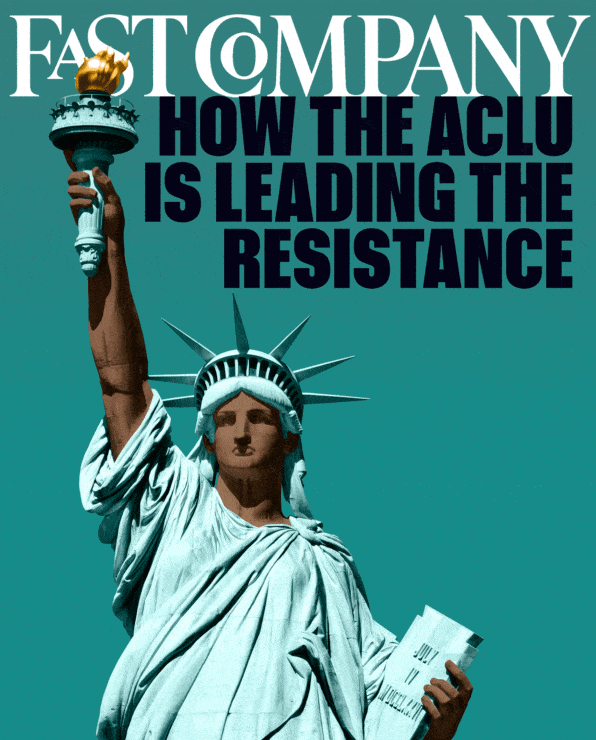
Keeping Up Momentum
There’s no doubt the ACLU is having a moment. Romero’s job is to keep it going. At this year’s TED conference in Vancouver, he gave a rousing 15-minute speech on the importance of civic involvement, and received a standing ovation. He’s a confident public speaker, used to selling the importance of the ACLU’s mission, but his talk last week took the fiery tone of a leader whose organization depends on sustained public outrage. Referencing Silicon Valley’s obsession with disruption, Romero told the audience, “We have to disrupt our lives so that we can disrupt the amoral accretion of power by those who would betray our values. ‘We’ in ‘We the people’ must raise justice up, and must bring peace to our nation.”
Romero’s speech reflects a new emphasis on mobilizing members. It has become increasingly clear over the past six months that those hundreds of thousands of people who have recently joined the ACLU want to do more than just give money. “We’ve got [members] who really want to be put to work,” Romero says. “We have a responsibility to help them figure out how to make a difference.”
To mobilize public interest, Romero enlisted Faiz Shakir, a founding member and former editor-in-chief of the political news website ThinkProgress.org, who most recently served as a senior adviser to former Senator Harry Reid. Shakir assumed the role of national political director for the ACLU on inauguration day, and immediately set to work developing a grassroots-organizing arm. “I said to [Romero], ‘People are voting with their pocketbooks and email addresses,’” Shakir recalls. “[They’re saying,] tag, you’re it. You’re the leader of the resistance.”
In March, Shakir helped launch People Power, an online destination that offers citizens (whether or not they are ACLU members) resources for political engagement and advice on how to self-organize protests and rallies. Buoyed by the success of the Women’s March and other protests (including those at the airports during the travel ban), the ACLU hopes that its supporters will take further action to support its causes. People Power debuted with a live-streamed “town hall,” which offered the 200,000 people who had gathered at house parties around the country a basic understanding of their rights while protesting and initial ideas for action.

This kind of community engagement isn’t simply an opportunity to give supporters a sense of purpose. It also helps win cases. “Judges live in communities, and so a lot of what the judges are responding to is seeing people in the streets and seeing the protests and the press reports,” Romero explains. “Judges certainly make independent decisions based on the law, but they look around at what’s going on around them, and that changes their hearts and minds.”
In Shakir’s vision, the ACLU’s grassroots citizen activists will create town halls, lobby lawmakers, and organize protests, supplementing what he refers to as the “grass-top activities” of the ACLU affiliates: working with legislators, governors, business leaders, and other influential people. The ACLU is so invested in this new experiment that it is dedicating a planned $ 13 million over the next year to build People Power.
Public Council’s Rosenbaum credits Romero’s leadership for allowing the ACLU to seize this moment in history. “For a long time [the ACLU] won major cases that raised important issues,” he says. “That’s valuable, but it’s not the same thing as having a core vision and mission and executing and expanding it, and Anthony has done that. [Today] the ACLU is outsmarting and outmobilizing the government, whether it’s in the courts, legislative branches, or with grassroots organizing.”
Still, in this heated political climate, adopting high-profile stances and encouraging the public to take up causes in the organization’s name carry a certain amount of risk. The ACLU’s Washington, D.C.-based foundation, which is eligible to accept tax-deductible donations from individuals, corporations, and other charities, is prohibited from engaging too much in politics by its 501(c)3 status. The foundation funds the ACLU’s legal work, which supports the Constitution above all political parties or candidates. The nonprofit’s lobbying and organizing efforts, however, are paid for by the ACLU’s social-welfare entity, which relies on membership dollars that are not eligible for charitable-contribution deductions. The ACLU is careful to keep its two entities separate, but critics in the past have questioned its tax-exempt status.

Notably, when Romero described his ambitions for the ACLU in a February blog post, he compared it to another high-profile nonprofit with both a lobbying and foundation arm. “We are now half the size of the NRA,” he wrote, “but with continued growth, mobilization, and activism, we can build an even bigger force across a broader range of issues.” And while the ACLU, despite its nonpartisan stance, has traditionally faced opposition from the political right, that might be changing. Though the nonprofit doesn’t record the party affiliation of members, it has also seen a recent surge in donations from traditionally red states. “This president is our best recruiter,” Romero says.
The infusion of cash across the political spectrum has given the organization the opportunity to hire and expand beyond its People Power efforts. Two days before the president took the oath of office, Romero announced his seven-point plan for the next four years, which includes an increased focus on immigrant, reproductive, and LGBT rights.
To accomplish this, he says the ACLU will need an additional $ 100 million above the organization’s $ 220 million annual budget. The largest chunk of money, more than $ 40 million, will be used to create 100 new staff positions in affiliate offices, earmarked especially for states with large populations that often bring forward cases impacting national policy, such as Texas, Florida, and Ohio. The New York City-based national office will expand, adding around 90 staff positions via an infusion of $ 21 million.
The 97-year-old organization is also overhauling its digital tools and investing in its communications efforts, both of which have become priorities as public interest surges. “Our tech needs are woefully underresourced and underdeveloped,” Romero admits. “We have this massive flood of new [members], and I can’t even tell you the basic demographics. What was working fine for a membership of 400,000 people is not working for 1.6 million.”
Silicon Valley is lending a hand: The ACLU recently joined Y Combinator’s accelerator program, and now has the support of many of the engineers and business leaders associated with the incubator. (Romero says they are still identifying what projects to have them work on.) “We need leaders like [Romero] now more than ever,” says Altman, “and we wanted to play a small part in supporting his work.”
Romero is realistic that this time of rapid growth is likely to breed its share of failures. “We are definitely reengineering the place as we’re flying it,” he says, sounding remarkably like a startup founder. “Some things are going to work great, and some things aren’t.” That acceptance of the inevitability of failure helps him take the long view of the ACLU’s success.
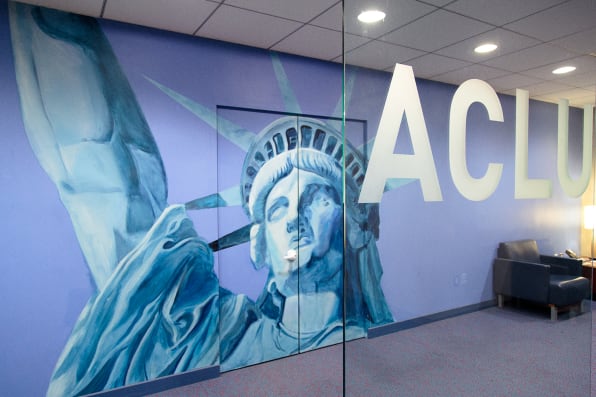
As Trump’s tumultuous first 100 days turn into the next 100, Romero isn’t concerned about burnout, even with the long hours his team is working. “[Our] job is to serve a mission, serve a cause,” he explains. “It’s a real privilege. I mean, if I weren’t doing this job, I would be crazy.”
He likens the ACLU to long-distance runners who have trained assiduously for this administration. “You’re building muscle for the marathon that you need to run,” he says. “We were building muscle in the Obama years that we’re putting to use now. We’re always laying the groundwork for that next moment, that next flashpoint, the next inflection point that really does test you.” And these days, that next inflection point may be right around the corner, ready to land on Romero’s desk at 5 p.m. on a Friday evening.
(97)

